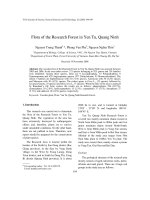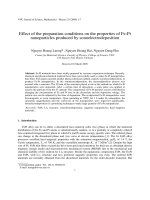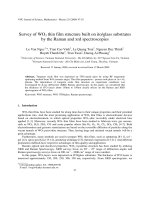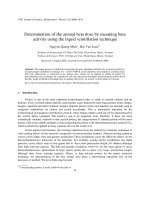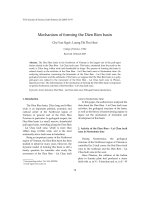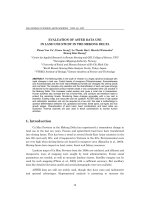Báo cáo " REPRESENTATIONS OF THE REAL DIAMOND LIE GROUP " potx
Bạn đang xem bản rút gọn của tài liệu. Xem và tải ngay bản đầy đủ của tài liệu tại đây (190.26 KB, 9 trang )
VNU. JOURNAL OF SCIENCE, Mathematics - Physics. T.XXI, N
0
3 - 2005
REPRESENTATIONS OF THE REAL DIAMOND LIE GROUP
Nguyen Viet Hai
Department of Mathematics, Hai Phong University
Abstract.
We present explicit formulas representations oftherealdiamondLiealgebra
obtained from the normal polarization on K-orbits. From this we have list irreducible
unitary representations of the real diamond Lie group that is coincide with the represen-
tations via Fedosov deformation quantisation. Here the computations are more simple for
use star-product.
1. Introduction
The method of orbits discovered in the pioneering works of Kirillov [8] is a uni-
versal base for performing harmonic analysis on homogeneous spaces and for construct-
ing new methods of integrating linear differential equations. We give the explicit form
of the representations of the real diamond Lie group which is coincide the representa-
tions obtained from the deformation quantisation (see [4, 5]). The representations first
appeared in the noncommutative integration method of linear differential equations as a
”quantum” analogue of the noncommutative Mishchenko-Fomenko integration method for
finite-dimensional Hamiltonian systems [9].
Quantum groups are group Hopf algebras, i.e. replace C*-algebras by special Hopf
algebras “of functions”. It is therefore interesting to ask whether we could describe quan-
tum groups as some repeated extensions of some kind quantum strata of coadjoint orbits?
We are attempting to give a positive answer to this question. It is not yet completely
described but we obtained a reasonable answer. Let us describe the main ingredients
of our approach. Let us in few words describe the structure of the paper. We intro-
duce on K-orbits in §2, Darboux coordinates, normal polarization on K-orbits and the
notion of the quantization of K-orbits in §3. Then, Hamiltonian functions in canonical
coordinates of the co-adjoint orbit O
ξ
, the operators
A
which define the representations
(the ξ−representations) of the real diamond Lie algebra are constructed in §4andfinally,
by exponentiating them, we obtain the corresponding unitary representations of the real
diamond Lie group R H
3
.
2. The description of K-orbits
From the orbit method, it is well-known that coadjoint orbits are homogeneous
symplectic manifolds with respect to the natural Kirillov structure form on coadjoint
Typeset by A
M
S-T
E
X
51
52 Nguyen Viet Hai
orbits. Let G be a real connected n-dimensional Lie group and g=LieGbeitsLiealgebra.
TheactionoftheadjointrepresentationAd
∗
of the Lie group defines a fibration of the
dual space g
∗
into even-dimensional orbits (the K-orbits). The maximum dimension of a
K-orbit is n − r,wherer =indg, the index of the Lie algebra, defined as the dimension of
the annihilator of a general covector. We say that a linear functional (a covector) ξ has
the degeneration degree s if it belongs to a K-orbit O
ξ
which dim O
ξ
= n − r − 2s, s =
0 , (n − r)/2.
We decompose the space g
∗
into a sum of nonintersecting invariant algebraic surfaces
Φ
s
consisting of K-orbits with the same dimension. This can be done as follows. We let
α
i
denote the coordinates of the covector F in the dual basis, F = f
i
e
i
with e
i
,e
j
= δ
i
j
,
where {e
j
} is the basis of g. The vector fields on g
∗
η
i
(F ) ≡ C
ij
(F )
∂
∂f
j
,C
ij
(F ) ≡ C
k
ij
f
k
are generators of the transformation group G acting on the space g
∗
, and their linear span
therefore constitutes the space T
F
O
ξ
tangent to the orbit O
ξ
running through the point
F . Thus, the dimension of the orbit O
ξ
is determined by the rank of the matrix C
ij
,
dimO
ξ
=rankC
ij
(ξ).
It can be easily verified that the rank of C
ij
is constant over the orbit. Therefore, equating
the corresponding minors of C
ij
(X) to zero and ”forbidding” the vanishing of lower-order
minors, we obtain polynomial equations that define a surface Φ
s
,
Φ
0
= {F ∈ g
∗
|¬(∆
1
(F )=0)};
Φ
s
= {F ∈ g
∗
| ∆
s
(F )=0, (∆
s+1
(F )=0)},s=1, ,
n − r
2
− 1;
Φ
n−r
2
= {F ∈ g
∗
| ∆
n−r
2
(F )=0}.
Here, by ∆
s
(F ) we denote the collection of all minors of C
ij
(F ) of the size n − r − 2s +2,
the condition ∆
s
(F ) = 0 indicates that all the minors of C
ij
(F )ofthesizen − r − 2s +2
vanish at the point F,and
(∆
s
(F ) = 0) means that the corresponding minors do not
vanish simultaneously at F.
Note that in the general case, the surface Φ
s
consists of several nonintersecting
invariant components, which we distinguish with subscripts as Φ
s
= Φ
sa
∪ Φ
sb
. (To
avoid stipulating each time that the space Φ
s
is not connected, we assume the convention
that s in parentheses, (s), denotes a specific type of the orbit with the degeneration degree
s.) Each component Φ
(s)
is defined by the corresponding set of homogeneous polynomials
∆
(s)
θ
(F )satisfyingtheconditions
η
i
∆
(s)
θ
(F )
∆
(s)
(F )=0
=0.
Representations of the real diamond Lie group 53
Although the invariant algebraic surfaces Φ
(s)
are not linear spaces, they are star sets, i.e.,
F ∈ Φ
(s)
, implies tF ∈ Φ
(s)
for t ∈ R
1
.
3. Darboux coordinates and normal polarization
By ω
ξ
we denote the Kirillov form on the orbit O
ξ
.Itdefines a symplectic structure
andactsonthevectorsa and b tangenttotheorbitas
ω
ξ
(a, b)=ξ, [α, β],
where a = ad
∗
α
ξ and b = ad
∗
β
ξ. The restriction of Poisson brackets to the orbit coincides
with the Poisson bracket generated by the symplectic form ω
ξ
. According to the well-
known Darboux theorem (see [arnold]), there exist local canonical coordinates (Darboux
coordinates) on the orbit O
ξ
such that the form ω
ξ
becomes
ω
ξ
= dp
k
∧ dq
k
; k =1, ,
1
2
dim O
ξ
=
n − r
2
− s,
where s is the degeneration degree of the orbit. Let be F ∈ O
ξ
,F = f
i
e
i
.Itcanbeeasily
seen that the trasition to canoniccal Darboux coordinates (f
i
) → (p
k
,q
k
)amountsto
constructing analytic functions f
i
= f
i
(q, p,ξ)ofvariables(p, q) satisfying the conditions
f
i
(0, 0, ξ)=ξ
i
;
∂f
i
(q, p,ξ)
∂p
k
∂f
j
(q, p,ξ)
∂q
k
−
∂f
j
(q, p,ξ)
∂p
k
∂f
i
(q, p,ξ)
∂q
k
= C
l
ij
f
l
(q, p,ξ).
We choose the the canonical Darboux coordinates with impulse p’s-coordinates. From
this we can deduce that the Kirillov form ω
ξ
locally are canonical and every element
A ∈ g =LieG can be considered as a function
˜
A on O
ξ
,linearonp’s-coordinates, i.e.
There exists on each coadjoint orbit a local canonical system of Darboux coordinates,
in which the Hamiltonian function
˜
A = a
i
(q, p,ξ)e
i
, A ∈ g,arelinearonp’s impulsion
coordinates and in theses coordinates,
a
i
(q, p,ξ)=α
k
i
(q)p
k
+ χ
i
(q, ξ); rankα
k
i
(q)=
1
2
dimO
ξ
. (1)
We have
Theorem 3.1. [2]) The linear transition to canonica coordinates on the orbit O
ξ
exists
if and only if there exists a normal polarization (in general, complex) associated with the
linear functional ξ, i.e., a subalgebra h ⊂ g
c
such that
dim h = n −
1
2
dim O
ξ
, ξ, [h, h] =0, ξ + h
⊥
⊂ O
ξ
.
In the classical method of orbits, the polarization appears as an (n −
1
2
dim O
ξ
)-
dimensional subalgebra h ⊂ g
c
, with its one-dimensional representation determined by the
54 Nguyen Viet Hai
functional ξ. In our case, a normal polarization determines linear transition (1) to the
canonical coordinates.
It can be easily seen that relacing the functional ξ with another covector belonging
to the same orbit leads to replacing the polarization h with the cojugate one
˜
h,withthe
Darboux coordinates corresponding to these two polarizations related by a point trans-
formation,
˜
q
k
=
˜
q
k
(q); ˜p
k
=
∂q
l
˜
q
k
p
l
. Therefore, the choice of a specificrepresentativeofthe
orbit is not essential. On the other hand, if the polarizations are not conjugate, the core-
sponding Darboux coordinates are related by a more general canonical transformation.
With the ”quantum” canonical transformation determined (with q and p being operators,
see below), we can thus construct the intertwining operator between the two representa-
tions obtained via the method of orbits involving two polarizations. In the case where no
polarization exists for a given functional, the transition to Darboux coordinates (which is
nonlinear in the p variables) can still be constructed, and the representation of g can still
be defined; this representation is the basis for the harmonic analysis on Lie groups and
homogeneous spaces (applications of the method of orbits to harmonic analysis go beyond
the scope of this paper and are not considered here). In other words, the existence of a
polarization is a useful property but is not necessary for the applicability of the method
of orbits.
We define the notion of the quantization of K-orbits. We now view the transition
functions f
i
(q, p; ξ) to local canonical coordinates as symbols of operators that are defined
as follows: the variables p
k
are replaced with derivatives, p
k
→ ˆp
k
≡−iW
∂
∂q
k
, and the
coordinates of a covector f
i
become the linear operators
f
i
(q, p; ξ) →
ˆ
f
i
q, −iW
∂
∂q
; ξ
(2)
(with W being a positive real parameter). We require that the operators
ˆ
f
i
satisfy the
commutation relations
i
W
[
ˆ
f
i
,
ˆ
f
j
]=C
l
ij
ˆ
f
l
.
If the transition to the canonical coordinates is linear, i.e., a normal polarization exists
for orbits of a given type, it is obvious that
ˆ
f
i
= −iWα
k
i
(q)
∂
∂q
k
+ χ
i
(q, ξ)(3)
With Hamiltonian function
˜
A = a
i
(q, p,ξ)e
i
, A ∈ g, the operators ˆa
i
as shown by evidence.
We note that in the ”classical” limit as W → 0, we have the commutator of linear
operators goes into the Poisson bracket on the coalgebra,
i
W
[·, ·] → {·, ·}.
We introduce the operators
k
(q, ∂
q
) ≡
i
W
ˆa
k
(q, p; ξ). (4)
Representations of the real diamond Lie group 55
It is obvious that
[
i
,
j
]=C
k
ij
k
Definition 3.2. Let f
i
= f
i
(q, p; ξ) be a transition to canonical coordinates on the or-
bit O
ξ
of the Lie algebra g. The operators
i
(q, ∂
q
) is called the representation (the
ξ-representation) of the Lie algebra g.
4.TherealdiamondLiegroup
The real diamond Lie group has a lot of nontrivial 2-dimensional coadjoint orbits,
which are the half-planes, the hyperbolic cylinders and the hyperbolic paraboloids (see
[11]). We should find out explicit formulas for each of these orbits. Our main result is find
the complete list of irreducible unitary representations of this group.
4.1 Preliminary results
The so called real diamond Lie algebra is the 4-dimensional solvable Lie algebra g
with basis X, Y , Z, T satisfying the following commutation relations, see [10]:
[X, Y ]=Z, [T, X]=−X, [T, Y ]=Y,
[Z, X]=[Z, Y ]=[T, Z]=0.
These relations show that this real diamond Lie algebra g = R h
3
is an extension of the
one-dimensional Lie algebra RT by the Heisenberg algebra h
3
with basis X, Y, Z,where
the action of T on Heisenberg algebra h
3
is defined by the matrix
ad
T
=
−100
010
000
TherealdiamondLiealgebraisisomorphictoR
4
as vector spaces. The coordinates in
this standard basis is denote by (a, b, c, d). We identify its dual vector space (R h
3
)
∗
with R
4
with the help of the dual basis X
∗
,Y
∗
,Z
∗
,T
∗
and with the local coordinates as
(α, β, γ, δ). Thus, the general form of an element of g is A = aX + bY + cZ + dT and the
general form of an element of (R h
3
)
∗
is ξ = αX
∗
+ βY
∗
+ γZ
∗
+ δT
∗
. The co-adjoint
action of the real diamond group G = R H
3
on (R h
3
)
∗
is given by
K(g)ξ,A = ξ, Ad(g
−1
)A, ∀ξ ∈ (R h
3
)
∗
,g ∈ R H
3
and A ∈ R h
3
.
Fixing ξ ∈ (R h
3
)
∗
and denote the co-adjoint orbit of R H
3
in R h
3
, passing through
ξ by
O
ξ
= K(G)ξ := {K(g)ξ |g ∈ R H
3
}.
By a direct computation one obtains (see 2, 7, also see [11]:
56 Nguyen Viet Hai
• Each point of the line α = β = γ = 0 is a 0-dimensional co-adjoint orbit
O
1
= O
(0,0,0,δ)
.
• The set α =0, β = γ = 0 is union of 2-dimensional co-adjoint orbits, which are just
the half-planes
O
2
= {(x, 0, 0,t) | x, t ∈ R, αx>0}.
• The set α = γ =0, β = 0 is a union of 2-dimensional co-adjoint orbits, which are
half-planes
O
3
= {(0,y,0,t) | y, t ∈ R, βy>0}.
• The set αβ =0, γ = 0 is decomposed into a family of 2-dimensional co-adjoint
orbits, which are hyperbolic cylinders
O
4
= {(x, y, 0,t) |x, y, t ∈ R & αx>0, βy>0,xy = αβ}.
• The open setγ = 0 is decomposed into a family of 2-dimensional co-adjoint orbits,
which are just the hyperbolic paraboloids
O
5
= {(x, y, γ,t) |x, y, t ∈ R & xy − αβ = γ(t − δ)}.
Thus,
O
ξ
= O
1
∪ O
2
∪ O
3
∪ O
4
∪ O
5
.
4.2. Hamiltonian functions in canonical coordinates of the orbits O
ξ
Each element A ∈ g canbeconsideredastherestrictionofthecorresponding
linear functional
˜
A onto co-adjoint orbits, considered as a subset of g
∗
,
˜
A(ξ)=ξ,A.It
is well-known that this function is just the Hamiltonnian function, associated with the
Hamiltonian vector field ξ
A
,defined by the formula
(ξ
A
f)(x):=
d
dt
f(x exp(tA))|
t=0
, ∀f ∈ C
∞
(O
ξ
).
It is well-known the relation ξ
A
(f)={
˜
A, f}, ∀f ∈ C
∞
(O
ξ
). Denote by ψ the
symplectomorphism from R
2
onto O
ξ
(p, q) ∈ R
2
→ ψ(p, q) ∈ O
ξ
.
Then we have:
Representations of the real diamond Lie group 57
Proposition 4.1. 1. Hamiltonian function
˜
A in canonical coordinates (p, q) of the orbit
O
ξ
is of the form
˜
A ◦ ψ(p, q)=
dp + aαe
−q
, on O
2
dp + bβe
q
, on O
3
dp + aαe
−q
+ bβe
q
, on O
4
(d ± bγe
q
)p ± ae
−q
± b(αβ − γδ)e
q
+ cγ, on O
5
.
2. In the canonical coordinates (p, q) of the orbit O
ξ
, the Kirillov form ω
ξ
is coin-
cided with the standard form dp ∧ dq.
Proof.
1. We adapt the diffeomorphism ψ to each of the following cases (for 2-dimensional
co-adjoint orbits, only)
• With α =0, β = γ =0
(p, q) ∈ R
2
→ ψ(p, q)=(αe
−q
, 0, 0,p) ∈ O
2
.
Element ξ ∈ g
∗
is of the form ξ = αX
∗
+ βY
∗
+ γZ
∗
+ δT
∗
, hence the value of the
function f
A
=
˜
A on the element A = aX + bY + cZ + dT is
˜
A(ξ)=F, A =
αX
∗
+ βY
∗
+ γZ
∗
+ δT
∗
,aX + bY + cZ + dT = αa + βb + γc + δd.
It follows that
˜
A ◦ ψ(p, q)=aαe
−q
+ dp, (5)
• With α = γ =0, β =0,
(p, q) ∈ R
2
→ ψ(p, q)=(0, βe
q
, 0,p) ∈ O
3
.
˜
A(F )=ξ,A = αa + βb + γc + δd. From this,
˜
A ◦ ψ(p, q)=bβe
q
+ dp. (6)
• With αβ =0, γ =0,
(p, q) ∈ R
2
→ ψ(p, q)=(αe
−q
, βe
q
, 0,p) ∈ O
4
.
˜
A ◦ ψ(p, q)=aαe
−q
+ bβe
q
+ dp. (7)
• At last, if γ = 0, we consider the orbit with the first coordinate x>0
(p, q) ∈ R
2
→ ψ(p, q)=(e
−q
, (αβ + γp − γδ)e
q
, γ,p) ∈ O
5
.
We have
˜
A ◦ ψ(p, q)=ae
−q
+ b(αβ + γp − γδ)e
q
+ cγ + dp
=(d + bγe
q
)p + ae
−q
+ b(αβ − γδ)e
q
+ cγ.
(8)
58 Nguyen Viet Hai
The case x<0 is similarly treated:
(p, q) ∈ R
2
→ ψ(p, q)=(−e
−q
, −(αβ + γp − γδ)e
q
, γ,p) ∈ O
5
.
˜
A ◦ ψ(p, q)=−ae
−q
− b(αβ + γp − γδ)e
q
+ cγ + dp
=(d − bγe
q
)p − ae
−q
− b(αβ − γδ)e
q
+ cγ. (9)
2. By a direct computation, we conclude that in the canonical coordinates the
Kirillov form is the standard symplectic form ω = dp ∧ dq.
The proposition is therefore proved. -
4.3. Representations of the real diamond group
Theorem 4.2. For each A ∈ R h
3
, representations of the real diamond algebra are
A
=
A
2
=
d∂
q
+ iaαe
−q
A
3
=
d∂
q
+ ibβe
q
A
4
=
d∂
q
+ i[aαe
−q
+ bβe
q
]
A
5
=
(d + bγe
q
)∂
q
+ i[ae
−q
+ b(αβ − γδ)e
q
+ cγ]
A
5
=
(d − bγe
q
)∂
q
+ i[−ae
−q
− b(αβ − γδ)e
q
+ cγ]
Proof. Applying directly (3), (4) we have:
1. If
˜
A = dp + aαe
−q
then
ˆ
A = −iWd∂q + aαe
−q
and from this,
A
2
(q, ∂
q
)=
i
W
[−iWd∂q + aαe
−q
]=d∂
q
+
i
W
aαe
−q
2. If
˜
A = dp + bβe
q
then
ˆ
A = −iWd∂q + bβe
q
and from this,
A
3
(q, ∂
q
)=
i
W
[−iWd∂q + bβe
q
]=d∂
q
+
i
W
bβe
q
3. If
˜
A = dp + aαe
−q
+ bβe
q
then
ˆ
A = −iWd∂q + aαe
−q
+ bβe
q
and from this,
A
4
(q, ∂
q
)=
i
W
[−iWd∂q + aαe
−q
+ bβe
q
]=d∂
q
+
i
W
(aαe
−q
+ bβe
q
)
4. At last, if
˜
A =(d ± bγe
q
)p ± ae
−q
± b(αβ − γδ)e
q
+ cγ we obtain
A
5
=
(d + bγe
q
)∂
q
+ i[ae
−q
+ b(αβ − γδ)e
q
+ cγ]
or
A
5
=
(d − bγe
q
)∂
q
+ i[−ae
−q
− b(αβ − γδ)e
q
+ cγ]
The theorem is therefore proved. -
As R H
3
is connected and simply connected Lie group, we obtain
Corollary 4.3. The irreducible unitary representations T of the real diamond Lie group
R H
3
defined by
T (exp A):=exp(
A
); A ∈ R h
3
Representations of the real diamond Lie group 59
More detail,
T (exp A)=
exp(d∂
q
+ iaαe
−q
)if
˜
A is defined by (4)
exp(d∂
q
+ ibβe
q
)if
˜
A is defined by (5)
exp(d∂
q
+ i[aαe
−q
+ bβe
q
]) if
˜
A is defined by (6)
exp((d + bγe
q
)∂
q
+ i[ae
−q
+ b(αβ − γδ)e
q
+ cγ]) if
˜
A is defined by (7)
exp((d − bγe
q
)∂
q
+ i[−ae
−q
− b(αβ − γδ)e
q
+ cγ]) if
˜
A is defined by (8)
This means that we find list all the irreducible unitary representations T (exp A)ofthereal
diamond Lie group R H
3
that is coincide the representations via Fedosov deformation
quantisation. What we did here gives us more simplisity computations in this case for use
the star-product (see [6], [4], [5], [7]).
References
1. V. I. Arnold, Mathematical Methods of Classical Mechanics, Springer Verlag, Berlin
- New York - Heidelberg, 1984.
2. Do Ngoc Diep, Noncommutative Geometry Methods for Group C*-Algebras,Chap-
man & Hall/CRC Research Notes in Mathematics Series, Vol. 416, 1999.
3. Do Ngoc Diep, Quantum Strata of Coadjoint Orbits, math.QA/0003100.
4 Do Ngoc Diep and Nguyen Viet Hai, Quantum half-planes via Deformation Quan-
tization, Beitr¨age zur Algebra und Geometrie (Contributions to Algebra and Ge-
ometry), Volume 42, No 2(2001), pp. 407-417.
5. Do Ngoc Diep and Nguyen Viet Hai, Quantum coadjoint orbits of the group of
affine transformations of the complex line,Beitr¨age zur Algebra und Geometrie
(Contributions to Algebra and Geometry), Volume 42, No 2(2001), pp. 419-430.
6. B. Fedosov, Deformation Quantization and Index Theory, Akademie der Wissensch
-aften Verlag, 1993.
7. Nguyen Viet Hai, Quantum co-adjoint orbits of MD
4
-groups, Vietnam J. Math.,
Vol 29, IS. 02/2001, pp.131-158.
8. A. A. Kirillov, Elements of the Theory of Representation, Springer Verlag, Berlin -
New York - Heidelberg, 1976.
9. A.S. Mishchenko and A.T.Fomenko, Selecta Math. Soviet, 2(1982), 207-291.
10. Vuong Manh Son and Ho Huu Viet, Sur la structure des C*-alg`ebres d’une classe
de groupes de Lie, J. Operator Theory, 11(1984), 77-90.
11. Le Anh Vu, The foliation formed by the K-orbits of maximal dimension of the real
diamond group, Vietnam J. Math., Vol 15, IS. 1987.
12 Le Anh Vu, On the structure of the C*-algebra of foliation formed by the K-orbits
of maximal dimension of the real diamond group, J. Operator Theory, 24(1990),
No 2. 227-238.
